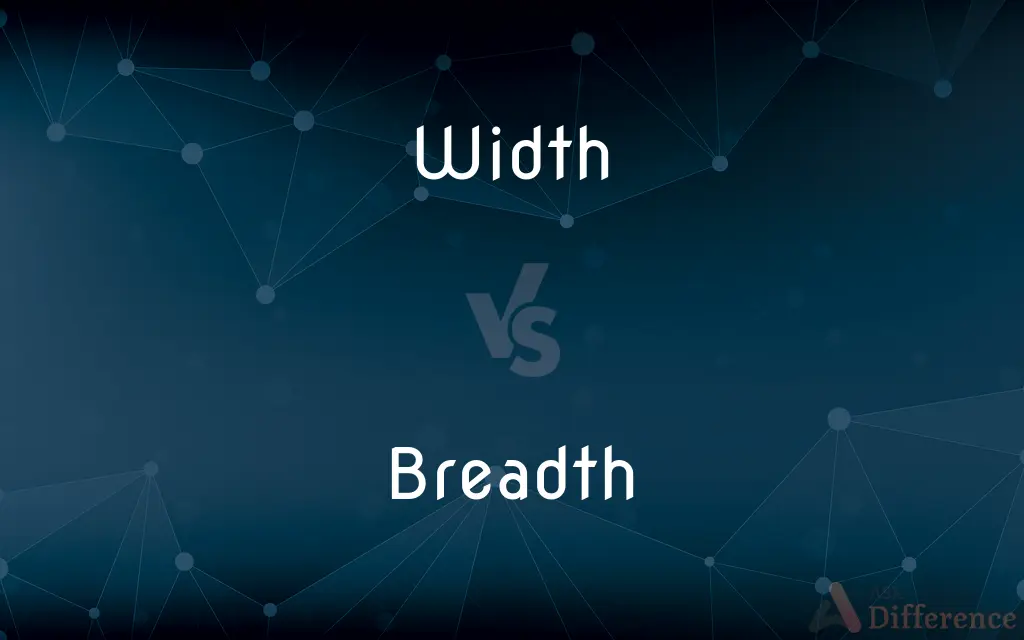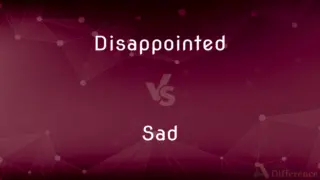Width vs. Breadth — What's the Difference?
By Tayyaba Rehman — Updated on November 2, 2023
Width refers to the measurement of something from side to side, while breadth often implies a wider sense of width, including a wider scope or range.

Difference Between Width and Breadth
Table of Contents
ADVERTISEMENT
Key Differences
Width specifically measures the distance from one side of an object to the other, often at the widest point. It's a linear measurement and is used in various contexts like measuring a piece of fabric, a room, or an electronic device. Width is a fundamental dimension in geometric shapes and is often used in everyday language to describe how wide something is.
Breadth, while similar to width in denoting the distance from side to side, carries a slightly broader connotation. In physical measurements, it's often interchangeable with width, but breadth can also imply a more expansive range or variety. For instance, one might speak of the breadth of knowledge, meaning a wide or comprehensive range.
When discussing physical objects, width is a term more frequently used in technical, mathematical, and practical contexts. For instance, in architecture, engineering, or carpentry, width is an important measurement for ensuring precision and accuracy in construction and design.
Breadth, on the other hand, is often used in more abstract or metaphorical senses, in addition to its use as a physical measurement. In education, for example, a curriculum with a wide range of subjects might be described as having considerable breadth. This usage highlights its more expansive, inclusive connotations.
Comparison Chart
Measurement
Side-to-side distance
Often interchangeable with width, but broader
ADVERTISEMENT
Usage
More technical and specific
Can be abstract or metaphorical
Context
Common in construction, design
Used in describing range or scope
Connotation
Linear, precise
Expansive, inclusive
Examples
Width of a table
Breadth of knowledge
Compare with Definitions
Width
Side-to-side measurement
The width of the window was 40 inches.
Breadth
Width in a broader sense
The breadth of the river was daunting.
Width
Broadness extent
He checked the width of the TV screen.
Breadth
Extensive range
The course offered a breadth of topics.
Width
The measurement or extent of something from side to side; the lesser of two or the least of three dimensions of a body
The yard was about seven feet in width
Breadth
Wide scope
The breadth of her expertise was impressive.
Width
Wide range or extent
The width of experience required for these positions
Breadth
Wide expanse
He admired the breadth of the landscape.
Width
The state, quality, or fact of being wide.
Breadth
Comprehensive width
The breadth of the study was notable.
Width
Abbr. w The measurement of the extent of something from side to side.
Breadth
The measure or dimension from side to side; width.
Width
A piece of material measured along its smaller dimension or its crosswise grain, especially a piece of fabric measured from selvage to selvage.
Breadth
A piece usually produced in a standard width
A breadth of canvas.
Width
The state of being wide.
Breadth
Wide range or scope
Breadth of knowledge.
Width
The measurement of the extent of something from side to side.
Breadth
Tolerance; broadmindedness
A jurist of great breadth and wisdom.
Width
A piece of material measured along its smaller dimension, especially fabric.
Breadth
An effect of unified, encompassing vision in an artistic composition.
Width
(cricket) The horizontal distance between a batsman and the ball as it passes him.
Breadth
The extent or measure of how broad or wide something is.
The breadth of the corridor is 4.5 metres.
Width
(sports) The use of all the width of the pitch, from one side to the other.
Manchester United like to play with width.
Breadth
A piece of fabric of standard width.
Width
The quality of being wide; extent from side to side; breadth; wideness; as, the width of cloth; the width of a door.
Breadth
Scope or range, especially of knowledge or skill.
Expand one's breadth of marketing
Width
The extent of something from side to side
Breadth
(arts) A style in painting in which details are strictly subordinated to the harmony of the whole composition.
Width
Distance across
She measured the width of the fabric.
Breadth
(graph theory) The length of the longest path between two vertices in a graph.
Width
Horizontal dimension
The width of the room was surprising.
Breadth
Distance from side to side of any surface or thing; measure across, or at right angles to the length; width.
Breadth of coloring is a prominent character in the painting of all great masters.
Width
Across measurement
The bridge's width was impressive.
Breadth
An ability to understand a broad range of topics;
A teacher must have a breadth of knowledge of the subject
Breadth
The extent of something from side to side
Common Curiosities
Can breadth mean more than physical width?
Yes, it implies wider scope.
Is width a linear measurement?
Yes, from side to side.
Is width used in mathematics?
Yes, it’s a common dimension.
Does breadth imply diversity?
Often, especially in abstract contexts.
Does width have metaphorical uses?
Less common than breadth.
Can breadth be used in education?
Yes, for range of subjects.
Are width and breadth interchangeable?
In physical dimensions, frequently.
Is width always horizontal?
Typically, but context matters.
Can breadth apply to experiences?
Yes, indicating wide variety.
Does breadth imply inclusivity?
Often, in broader contexts.
Is width relevant in clothing design?
Yes, for fitting and style.
Is breadth used in art?
Yes, for scope of styles or themes.
Is width important in architecture?
Absolutely, for structural planning.
How is width measured?
With tools like rulers or measuring tapes.
Can breadth relate to knowledge?
Yes, indicating comprehensive understanding.
Share Your Discovery

Previous Comparison
Disappointed vs. Sad
Next Comparison
Confectionery vs. PastryAuthor Spotlight
Written by
Tayyaba RehmanTayyaba Rehman is a distinguished writer, currently serving as a primary contributor to askdifference.com. As a researcher in semantics and etymology, Tayyaba's passion for the complexity of languages and their distinctions has found a perfect home on the platform. Tayyaba delves into the intricacies of language, distinguishing between commonly confused words and phrases, thereby providing clarity for readers worldwide.
















































